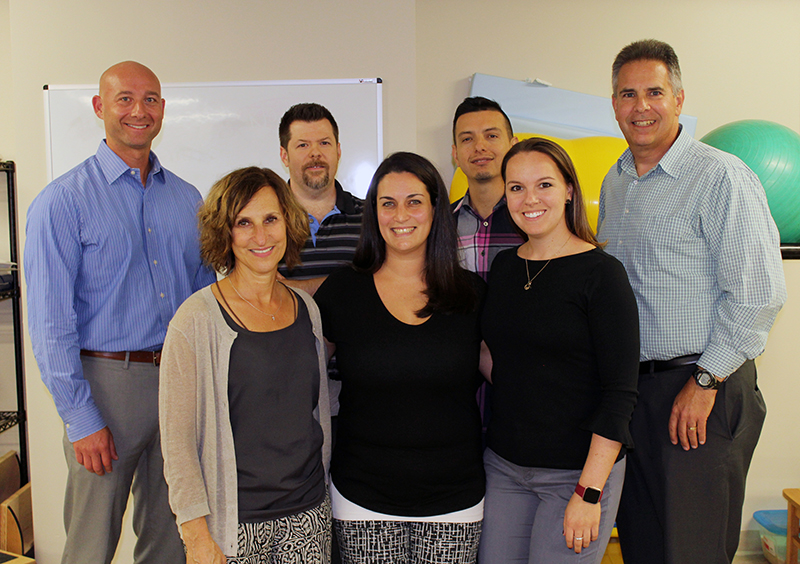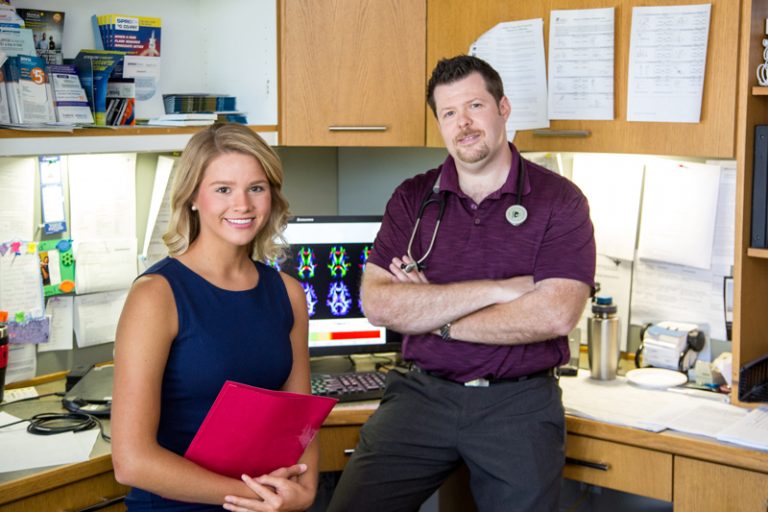As the focus on concussion in the athletic and scholastic community is growing significantly, a need is present in the community served by the Bon Secours Charity Health System for appropriate concussion education, prevention, diagnosis and management. This need is recognized by both state and federal lawmakers who have made significant strides towards a more expertly derived and systematically implemented set of guidelines to address this problem. Chief among state and federal guidelines is the need for educational updates on concussion for coaches, athletes and parents, timely identification of possible concussion by event officials and athletic trainers, appropriate diagnosis by a physician specifically trained in concussion as well as implementation and coordination of management by those same physicians. These guidelines also call for the availability of computerized neurocognitive testing to aid in the diagnosis and management of concussion.
The Bon Secours Concussion Management and Rehabilitation Program was created by Dr. Nicholas Belasco in response to this need. Using the most up-to-date technology, like ImPACT and the Sway Balance system, it provides an all-inclusive service to school systems, as well as club teams and other local sports organizations, who would like to make sure they comply with the rapidly developing federal guidelines on concussion as well as provide the best possible care to their athletes who suffer from concussion.

Vestibular Therapy Team Members
There are many different facets to concussion evaluation and management, including cognitive function, orientation, postural balance, memory, exertion, and neurological symptoms. The Sway System provides rapidly obtained objective measurements to a wide array of medical conditions, providing an objective measurement of balance, motion reaction time and symptom scoring. This quantitative analysis supports acute or long term medical decision making and provides the ability to track outcomes and recovery scenarios. Sway is an FDA and Health Canada cleared medical device that is accessible via a computer or mobile device, which syncs with a HIPAA compliant, cloud based server for immediate access to patient information.
Dr. Belasco is the only concussion specialist in the region who is a credentialed ImPACT consultant. Using tools such as the ImPACT Concussion Management Model, ImPACT addresses the need for an accurate, medically accepted assessment system that is used as a part of an overall concussion management protocol. This Model builds partnerships with healthcare professionals and athletic trainers to offer training and resources for affordable concussion management. ImPACT benefits athletes at all levels of play, from professional sports teams to students and their parents.
Developed by clinical experts who pioneered the field, ImPACT (Immediate Post-Concussion Assessment and Cognitive Testing) is the most widely used and most scientifically validated computerized concussion evaluation system. ImPACT is an FDA cleared screening tool that provides trained clinicians with neurocognitive assessment tools and services that have been medically accepted as state-of-the-art best practices as part of determining safe return to play decisions.
Additionally, Diffusion Tensor Imaging (DTI) is now available and has the potential to help physicians understand concussions by providing quantitative measurements of the subtle changes within the white matter tissue in the brain following a concussion. DTI is performed by using an MRI machine that is equipped with specialized software that measures the movement of water in nerve fibers in the brain. Mild concussion is difficult to diagnose because often the brain appears quite normal on conventional MRI so the solution is to use neuroimaging tools such as DTI to detect brain injuries in mild traumatic brain injury.
Thanks to the Bon Secours Concussion Management and Rehabilitation Program, every school system, no matter how small, has the opportunity to provide the kind of concussion education and care previously only manageable by the largest and best supported colleges and universities. It also allows schools that have already started implementing concussion services to bring their programs to the next level of excellence.
The program works in collaboration with the Rehabilitation Medicine Programs across the system. To learn more about the Rehabilitation Medicine Program click HERE
Nicholas Belasco, DO, sports medicine specialist and Director of the Concussion Management and Rehabilitation Program at Bon Secours Medical Group, a member of the Westchester Medical Center Health Network, discusses symptoms of concussions and how to treat them on WRCR Radio. Tune in.
Hear From Our Patients

Testimonial: Britta Beck
Time Out

Sidelined by a head injury, a student athlete reshaped her life – and the way people think about concussions.
By Melissa Pheterson
“You’ll be fine.”
That’s what Britta Beck recalls being told after another player’s knee slammed into her temple during a volleyball game. The Delaware Valley, PA, athlete was discharged from a local hospital and advised to just rest.
Beck returned home and read a book to prepare for a test. The next day, pen in hand, she racked her brain for answers — but she could not recall a single word she’d read the day before.
“That’s when I realized this was far more than ‘just’ a concussion,” says Beck.
Although the results of her MRI were normal, Beck was experiencing acute headaches, impaired speech, fuzzy memory, severe dizziness and sleep disruptions. “Being a coordinated athlete, it was strange to close my eyes and lose my balance. And when I was talking, I’d trail off mid-sentence and forget the word I needed.”
Beck and her family turned to Nicholas Belasco, DO, CIC, a sports-medicine physician and the Medical Director of the Bon Secours Concussion Management and Rehabilitation Program, a member of the Westchester Medical Center Health Network (WMCHealth).
As a regional expert on concussions, Dr. Belasco began a thorough evaluation of his young patient, coordinating a program of therapies that recruited various specialists to address Beck’s cognitive and balance issues.
“When it comes to concussions, there is a remarkable amount of misunderstanding and misinformation,” says Dr. Belasco, whose WMCHealth concussion-and-rehab center treats between 1,500 and 2,000 head injuries a year and recently entered into a partnership with the CDC.
“There can be a dramatic lack of resources to coordinate care, and this can lead to disruptions of the recovery process.”
Dr. Belasco also notes the biases working against the proper diagnosis of Beck’s injury — like the common belief that concussions only happen to male athletes playing “high-risk” sports, such as football or basketball. “Many articles in the last decade report that women and girls are actually at greater risk, perhaps because of neck strength,” he says. “They tend to have more frequent concussions, take more time to recover and report more academic and cognitive dysfunction afterward.”
Given Beck’s struggles with recollection and speech, and a heightened sensitivity to light, the first step was to allow her brain to heal through a few solid months of rest. She then began an intensive therapy regimen to keep her on track to graduate on time, without pushing her too hard. “In designing these programs,” says Dr. Belasco, “my goal is to pinpoint the problems that affect the patient most, tackle the issues that underpin others and determine the path that drives the straightest course to recovery — all while balancing the demands of school or work.”
Dr. Belasco’s coordination of Beck’s case has helped the hospital develop a Concussion Management program of community-based services that are unique to the region, for moderate-to-severe concussions and traumatic brain injuries. “I wanted to get back to normal so badly,” Beck recalls. “Looking back, though, not rushing to get back to school and trusting Dr. Belasco were the best things I could have done.”
Dr. Belasco draws a distinction between passive rest (the traditional approach) and active recovery, a newer concept. “This idea that: ‘We’ll shut everything down so they can rest, rest, rest,’ interferes with a teenager’s social life, academics and sense of self — often aggressively,” he says. “If we don’t minimize disruptions to the normal environment, patients fall into a weird limbo where they’re not participating in their own care. I’m a sports-medicine doctor, so our approach to care is active. I wanted Britta’s brain rehabbing, not just resting.”
Speech therapy, vestibular therapy (an exercise-based program to address dizziness) and occupational therapy combined to help Beck regain the functions she had lost. Medication designed to stabilize sleep and treat headaches also helped — both key for expediting recovery. “We have to borrow from other fields of medicine a lot, there are not many direct FDA-approved treatment options for concussion,” Dr. Belasco says. “Medications that modify or minimize symptoms have to be used carefully. Kids really need some biofeedback from their symptoms to know where they are in terms of recovery.”
Despite this new approach to recovery, Britta’s social circle remained fractured. When she returned to school with a modified schedule and permission to nap in the nurse’s office, Beck recalls hearing jabs such as: “You’re so lucky; you get to leave early” or “I had a concussion and was fine. You’re just faking it.”
Yet, Beck stayed the course to graduate on time, sticking to her doctor’s prescribed restrictions on visual stimulation and daily distractions, such as cell phones and computers. “Being a teenager, that’s very hard, but I trusted Dr. Belasco, and that’s how I got better,” she says.
Today, Beck pursues a blended major of neuroscience and neuropsychology at Endicott College in Massachusetts. She has resumed her athletics, swimming regularly and is even training for triathlons. She continues to struggle with headaches and fatigue, but it doesn’t hold her back. “In college,” she jokes, “everybody naps.” Last summer, she completed an internship at Dr. Belasco’s office, researching how mouthguards with sensor technology might help shield football players from head injuries.
“The fact that she’s an athlete, had an injury and went through recovery gives Britta credibility among teens who may feel like they aren’t being heard from other adults,” says Dr. Belasco. “They can relate to her, and she gives us exemplary insight and clinical acumen.”
Beck, in turn, wants to bolster resources for prevention and recovery for those at risk of head injury. “People think concussions are a little bump on the head,” Beck says. “I want them to understand that concussions can be serious, even severe, but that recovery is possible.”